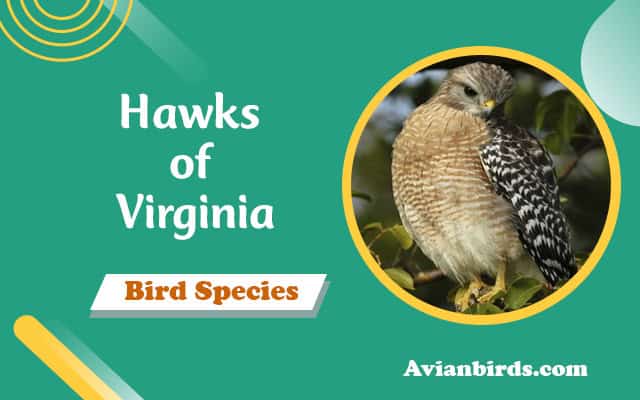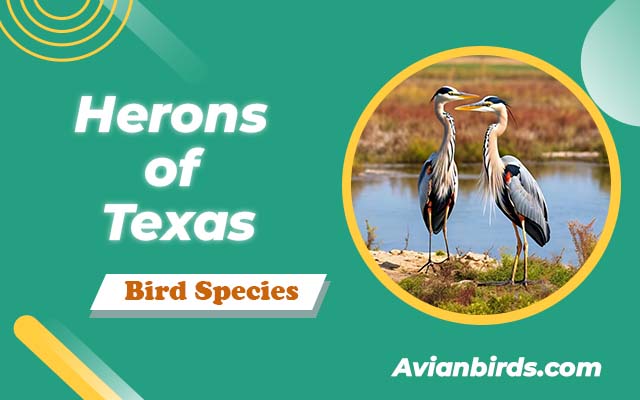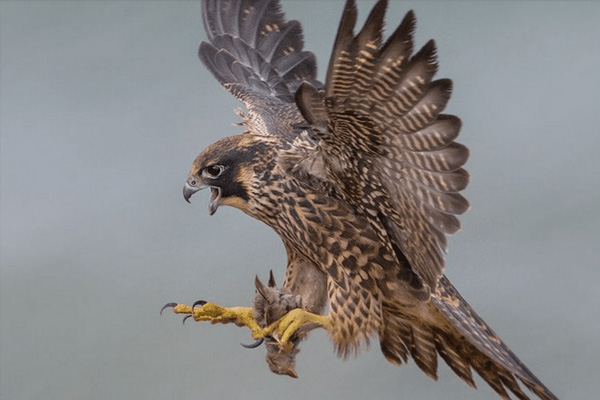7 Types of Hawks in Virginia (ID Guide With Pictures)
Did you know Virginia has seven different types of hawks? These birds are key to Virginia’s wildlife and offer great birdwatching spots. Hawks vary in size, from 9.4 inches to 25.6 inches for the Red-Tailed Hawk. Each has special features that make identifying them fun.
This guide will explore Virginia’s hawk world. We’ll look at their looks, homes, and how they hunt. Whether you love birds or are just starting, you’ll find out where to see these amazing birds in Virginia. So, get ready to learn about Virginia’s incredible hawks!
Introduction to Hawks in Virginia
Thanks to its diverse landscapes, Virginia is home to many hawk species. From dense forests to wide wetlands, hawks find the perfect place to live. This guide introduces you to hawks and their important role in Virginia’s nature.
Hawks are known for their sharp eyesight and hunting skills. They are a favorite among birdwatchers. As you explore Virginia, look for hawks like the Red-tailed Hawk and the Cooper’s Hawk.
The Red-tailed Hawk lives in many habitats, while the Cooper’s Hawk prefers suburban areas. The Broad-winged Hawk is famous for its long migration to warmer places in Central and South America.
Learning about hawk behaviors and habitats makes birdwatching more exciting. Watching a Sharp-shinned Hawk fly or seeing a Red-shouldered Hawk soar will make you appreciate Virginia’s wildlife more.
1. Red-shouldered Hawk
- Scientific Name: Buteo lineatus
- Size: 16 to 24 inches (40 to 61 cm)
- Weight: 1.0 to 2.5 pounds (0.45 to 1.13 kg)
- Lifespan: 10 to 15 years
- Diet: Small mammals, birds, amphibians, reptiles
- Call: Loud, ringing “kee-kee-kee” sound
The Red-Shouldered Hawk is a striking and vocal member of the hawk family. It’s a favourite among birdwatchers in Virginia. Its vibrant plumage and distinctive calls make it easy to spot. Knowing about its identification, habitat, diet, and breeding habits can deepen your appreciation for this bird.
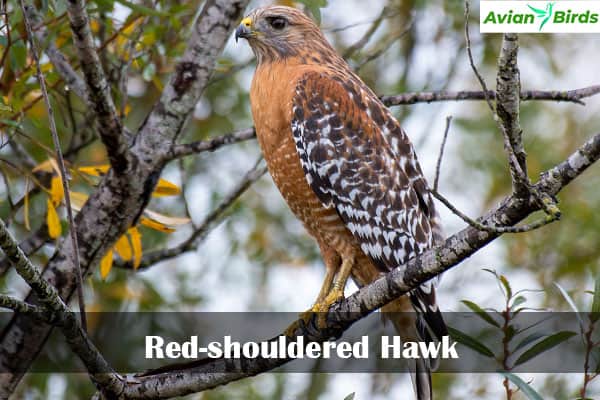
Identification Features
The Red-Shouldered Hawk has remarkable identification characteristics. Adults have a reddish-brown head and breast with dark and white checkered wings. Their elongated tail has bold black-and-white bands. Near the tips, there are translucent crescents.
Males and females look similar, but females are larger. These medium-sized birds are 17 to 24 inches long. They have a wingspan of 37 to 44 inches and weigh 17 to 27 ounces.
Habitat and Distribution
Spotting a Red-Shouldered Hawk is easier in deciduous woodlands near rivers, swamps, and wetlands. They thrive in these forest habitats from southeastern Canada to Mexico. In Florida, hawks have paler heads than those in California.
Diet and Feeding Behavior
The Red-Shouldered Hawk’s diet includes small mammals, amphibians, frogs, and reptiles. They hunt from perches or in flight. This adaptability helps them find various food sources.
Breeding and Nesting
Breeding starts in April. They build stick nests in large trees, often near water. Pairs lay 2 to 5 eggs, spaced every couple of days. Both hawks actively participate in courtship, which includes aerial displays.
They show strong monogamous tendencies, reusing nests year after year.
| Characteristic | Measurement |
|---|---|
| Length | 17 to 24 inches |
| Wingspan | 37 to 44 inches |
| Weight | 17 to 27 ounces |
| Eggs per clutch | 2 to 5 |
| Call | Rising, whistled kee-rah |
2. Red-Tailed Hawk
- Scientific Name: Buteo jamaicensis
- Size: 18 to 26 inches (46 to 66 cm)
- Weight: 1.5 to 3.5 pounds (0.68 to 1.59 kg)
- Lifespan: 10 to 20 years in the wild
- Diet: Small mammals (like rodents), birds, and reptiles
- Call: A distinctive, raspy “kee-eee-kee” sound
The Red-Tailed Hawk is a well-known bird in North America. It has striking features and lives in many places. Birdwatchers and nature lovers find it fascinating because of its beauty and hunting skills.
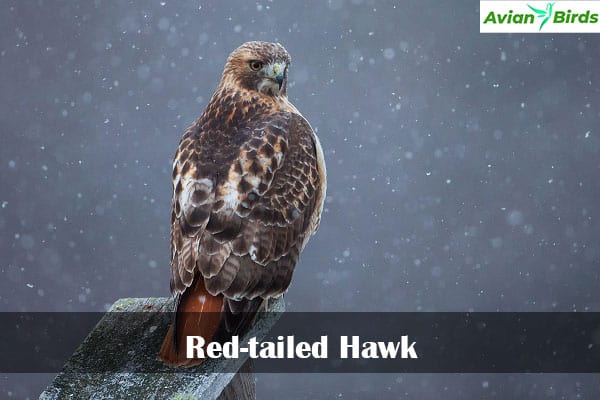
Identification Features
The Red-Tailed Hawk has a broad reddish tail. This is a key feature for spotting them. Adults are 19.7 to 25.6 inches long and have a wingspan of 44.9 to 52.4 inches.
They have dark brown upperparts and a lighter breast. The colours can vary, making them tricky to identify. But their red tail makes them easy to spot as they fly.
Habitat and Distribution
Red-Tailed Hawks live in many places in Virginia. They like woodlands, open fields, and suburbs. This wide range means they are often seen in the state.
They can be spotted perched high or flying overhead. They look for their next meal as they go.
Diet and Feeding Behavior
Red-tailed hawks mainly eat small mammals. They love rodents and rabbits. They have interesting ways of hunting.
They often soar high and then swoop down to catch prey. Sometimes, they sit quietly and wait. This shows their patience and strength.
Must visit: Hawks in Massachusetts
3. Cooper’s Hawk
- Scientific Name: Accipiter cooperii
- Size: 14 to 20 inches (36 to 51 cm)
- Weight: 1.0 to 1.5 pounds (0.45 to 0.68 kg)
- Lifespan: About 2 to 5 years in the wild, up to 15 years in captivity
- Diet: Primarily small birds, but also feeds on small mammals and insects
- Call: A series of quick, sharp “kak-kak-kak” sounds
The Cooper’s Hawk (Accipiter cooperii) is a medium-sized raptor found in Virginia. It has unique physical traits and behaviors. Knowing how to identify a Cooper’s Hawk can make birdwatching more fun.
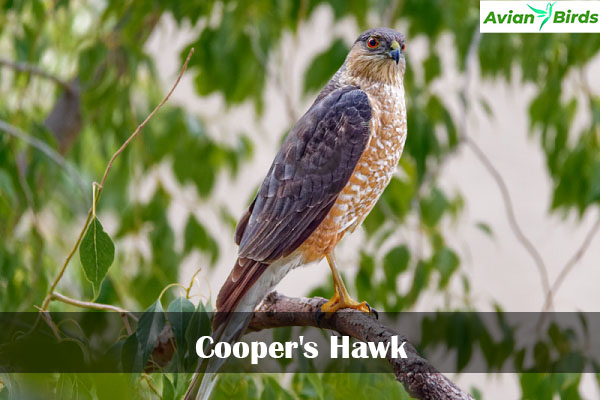
Identification Features
Adult Cooper’s Hawks have reddish-barred chests and reddish eyes. They are 14.6 to 15.3 inches long and have a 24.4 to 35.4 inches wingspan. Their upperparts are deep brown, and their underparts are white with brown streaks.
Young birds are dark brown with a mottled look. They look hooded. In flight, they have a long, rounded tail that is longer than their wings.
Habitat and Distribution
Cooper’s Hawks live in many places, from woodlands to suburban areas. In Virginia, they are often seen in leafy areas and backyards. They hunt small birds at feeders.
Their range goes from southern Canada to Mexico. Hawks in the East, like Virginia, are bigger than those in the West. Western hawks are smaller and weigh less.
Diet and Feeding Behavior
Cooper’s Hawks eat small to medium-sized birds, small mammals, and sometimes reptiles. They are stealthy hunters. They chase birds in urban areas, using feeders to their advantage.
Breeding and Nesting
The breeding season starts in March. Males do impressive courtship flights to attract females. They build big nests in tall trees using twigs.
They can have two to four fledglings a season. But bad weather and human impact can hurt their success. Still, Cooper’s Hawks are stable and adaptable.
| Characteristic | Details |
|---|---|
| Adult Appearance | Reddish-barred chest, reddish eyes, blue-gray upperparts |
| Immature Appearance | Dark brown above, whitish mottling, hooded look |
| Size | 14.6 to 15.3 inches in length, wingspan 24.4 to 35.4 inches |
| Habitat | Wooded areas, suburban regions, backyards |
| Diet | Small to medium-sized birds, small mammals, and occasional reptiles |
| Breeding | From March to August, 2 to 4 fledglings per season |
| Distribution Range | Southern Canada to Mexico, larger in the East |
4. Sharp-Shinned Hawk
- Scientific Name: Accipiter striatus
- Size: 9 to 13 inches (23 to 33 cm)
- Weight: 3 to 8 ounces (85 to 225 grams)
- Lifespan: About 3 to 5 years in the wild, up to 15 years in captivity
- Diet: Primarily small birds, but can also eat small mammals and insects
- Call: A series of sharp, high-pitched “kik-kik-kik” sounds
The Sharp-Shinned Hawk is the smallest hawk in Virginia. It is known for its amazing agility and special hunting ways. Its Sharp-Shinned Hawk identification makes it easy to spot. It has the right size and looks.

Identification Features
Adult Sharp-Shinned Hawks have slaty blue-grey upper parts and narrow red-orange bars on their breasts. Young ones have a brown colour with vertical streaks on white underparts. Males are as big as a blue jay, while females are as big as a male Cooper’s Hawk.
They have a unique flight style. It includes quick wingbeats and short glides. This makes them very agile in the air.
Habitat and Distribution
Sharp-shinned hawks live in forests and forest edges. This helps them hide while hunting. Their range can change.
Some stay in their breeding areas all year. Others migrate south for milder weather in winter. They are often seen near bird feeders, hunting small songbirds.
Behavior and Diet
Sharp-shinned hawks are stealthy hunters. They mainly eat small birds, insects, small rodents, and reptiles. In winter, they hunt along forest edges, using their speed and camouflage.
Telling them apart from Cooper’s Hawks can be hard. Sharp-shinned Hawks have a squared tail. Cooper’s Hawks have a longer, rounded tail.
| Characteristic | Males | Females |
|---|---|---|
| Average Size | Similar to Blue Jay | Equivalent to Crow |
| Weight Range | 3.1 – 7.7 oz | Heavier than Males |
| Hunting Preference | Small birds | Small birds, insects, small rodents |
| Habitat | Forests, Forest Edges | Forests, Forest Edges |
Must read: Hawks In Arizona
5. Broad-Winged Hawk
- Scientific Name: Buteo platypterus
- Size: 14 to 20 inches (36 to 51 cm)
- Weight: 1.5 to 2.5 pounds (0.68 to 1.13 kg)
- Lifespan: About 10 to 15 years in the wild
- Diet: Small mammals, birds, amphibians, and reptiles
- Call: A series of short, raspy “pee pee pee” sounds
The Broad-Winged Hawk (Buteo platypterus) is easy to spot in the sky. It’s a key bird to know in Virginia. Learning how to identify it can make birdwatching more fun.
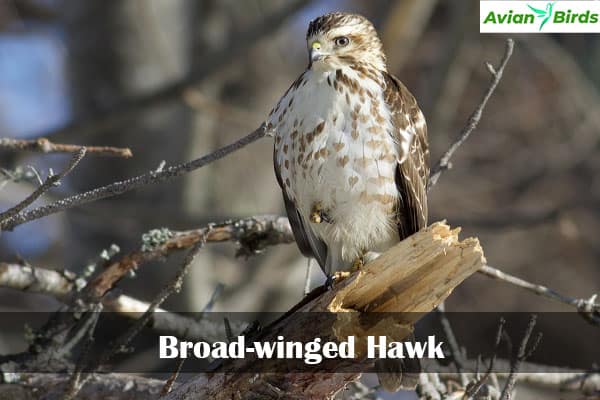
Identification Features
Spotting a Broad-Winged Hawk takes a keen eye. Adults have dark brown tops and bright reddish-brown heads. Their bellies are pale with horizontal bars.
Their broad tail has bold black and white bands. Young hawks are lighter brown with coarse streaks and narrow tail bands. Rare dark-morph hawks are mostly found in the west and during migrations.
Migration Patterns
Fall migrations of Broad-Winged Hawks are a sight to see. They fly in huge flocks, sometimes with tens of thousands of birds. They form “kettles” in the sky, drawing more birds.
This migration starts in late summer and goes into fall. They head to northern South America. Some hawks travel over 4,350 miles, flying about 69 miles a day.
Habitat Preferences
Broad-winged hawks like dense, mature forests. They prefer large deciduous or mixed forests. They nest high in trees in April.
They hunt from perches or while soaring. This lets them see small animals in their forest home.
Also visit: Hawks in New York
6. Rough-legged Hawk
- Scientific Name: Buteo lagopus
- Size: 20 to 24 inches (51 to 61 cm)
- Weight: 1.5 to 3.5 pounds (0.68 to 1.59 kg)
- Lifespan: About 10 to 15 years in the wild
- Diet: Primarily small mammals (like voles and lemmings), but also birds and carrion
- Call: A soft, low “kreeee” sound, often less vocal than other hawks
The Rough-Legged Hawk is a striking bird with unique feathered legs. It has different looks based on its morph type, like light and dark. Adult males in the light morph have mottled wings and look lighter overall. Females often have a bigger black belly patch.
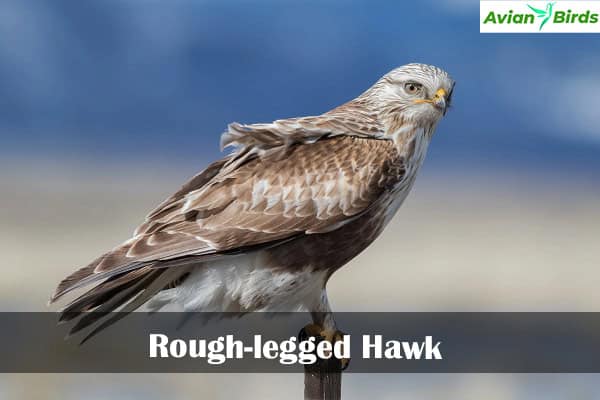
Dark morphs have pale flight feathers, giving them a two-toned look. They are bigger than American Crows but smaller than Red-tailed Hawks.
Identification Features
To spot a Rough-Legged Hawk, look for its dark-brown colouring. Their tails are dark at the tips and pale at the base. They hover in the wind to hunt small mammals and birds.
It’s easier to identify them during winter when they are in Virginia. Their size and plumage stand out then.
Winter Migration in Virginia
Rough-legged hawks migrate from the Arctic tundra to Virginia in winter. They are best seen in cold, snowy fields with patchy trees. They linger to find food in open landscapes.
They mostly stay in agricultural fields and marshes. Nonbreeding adults eat about a quarter-pound of food daily. This is like five small mammals keeping them active.
Habitat Preferences
This species loves open spaces, like agricultural lands, wetlands, and fields. Look for them in places with lots of small mammals. They hunt in areas with vole urine, showing their sharp vision.
Must visit: Hawks in Wisconsin
7. Northern Harrier
- Scientific Name: Circus cyaneus
- Size: 16 to 24 inches (40 to 61 cm)
- Weight: 1.0 to 2.4 pounds (0.45 to 1.1 kg)
- Lifespan: About 3 to 5 years in the wild
- Diet: Small mammals, birds, and sometimes insects
- Call: A series of high-pitched “ki-ki-ki” sounds
The Northern Harrier, known as Circus hudsonius, is unique among hawks. It has long wings, a long tail, and a white rump. Knowing about its features, where it lives, and how it behaves makes it more interesting.
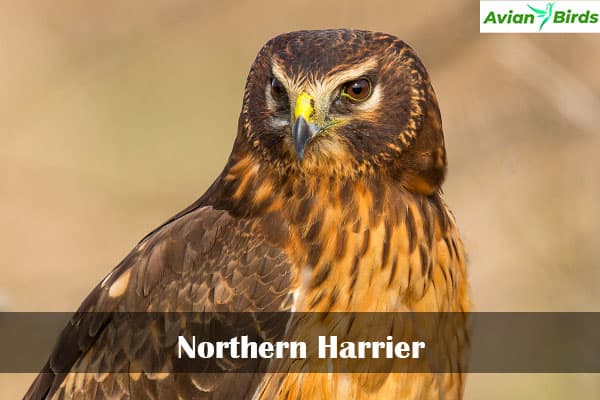
Identification Features
Adult Northern Harriers have clear differences. Males are gray with a white rump patch. Females are pale with brown streaks. Young birds have a cinnamon belly and darker heads. These differences make them fun to watch.
| Feature | Males | Females | Immature |
|---|---|---|---|
| Coloration (Above) | Gray with dark trailing edges | Dark brown | Dark brown |
| Colouration (Below) | Pale with black wingtips | Pale with brown streaking | Cinnamon wash, unstreaked |
| Distinctive Feature | White rump patch | White rump patch | None |
Habitat and Distribution
Northern Harriers live in open fields, marshes, and grasslands in Virginia. They like places with lots of food. They move from the Arctic to prairies to breed. In Virginia, they glide over fields and marshes.
Behavior and Diet
Watching Northern Harriers is fascinating. They glide low to hunt, weaving through fields. They hover and then pounce. They eat small rodents and birds, making them good hunters.
Where to Spot Hawks of Virginia
Virginia is great for hawk-watching. It has many places to see hawks, whether you’re new or experienced. The state’s different landscapes are perfect for spotting many hawk species.
Best Locations for Birdwatching
Top hawk-watching spots include:
- Shenandoah Valley
- Blue Ridge Mountains
- Chesapeake Bay wetlands
- Rockfish Gap on the Blue Ridge Parkway
- Linden Fire Tower in Northern Virginia
These places are known for great hawk sightings. Many people visit Skyline Drive and the Blue Ridge Parkway. There, hundreds of hawks can be seen during migration.
Seasonal Timing for Optimal Viewing
The best times to see hawks are in spring and fall, especially from mid-September to early October. This is when hawks migrate south for the winter.
Historical records show that Linden Fire Tower can see up to 17,000 broad-winged hawks on a peak day.
| Location | Best Times to See Hawks | Notable Counts |
|---|---|---|
| Rockfish Gap | September 15 | Estimated 10,000 broad-winged hawks |
| Linden Fire Tower | Third week of September | Over 17,000 broad-winged hawks in one day |
| S Skyline Drive | Late September to early October | Variety of hawk species |
For the best hawk watching, go during these peak times. It’s a chance to see an amazing bird migration.
Read More🐦Related Articles:
| Owls In Oregon |
| Owls in New Jersey |
| Owls in Minnesota |
| Common Shelduck: Colorful Coastal Duck Species |
| Owls in Africa |
Conclusion
Exploring the hawks in Virginia makes birdwatching more exciting. It also shows how important it is to protect hawks. Each hawk, like the Red-Shouldered Hawk and the Broad-Winged Hawk, has special features and ways of living.
When you go birdwatching in Virginia, use some helpful tips. Bring binoculars to see better, stay away from nests, and talk to birdwatching groups. Sharing what you see helps protect these amazing birds.
In short, Virginia’s hawks are amazing and need our care. Watching them and helping protect their homes makes the world better for all. Every time you see a hawk, you help keep their homes safe.
Frequently Asked Questions
Q1. What types of hawks can I find in Virginia?
In Virginia, you can see many hawks. These include the Red-Shouldered Hawk and the Red-Tailed Hawk. You’ll also find Cooper’s Hawk, Sharp-Shinned Hawk, and Broad-Winged Hawk. Other species are the Rough-Legged Hawk and the Northern Harrier. Each has its own look and where it likes to live.
Q2. Where is the best place to spot hawks in Virginia?
The best spots for seeing hawks are state parks and wildlife refuges. Coastal areas are also great, especially in the Shenandoah Valley. The Chesapeake Bay wetlands and the Blue Ridge Mountains are excellent, too.
Q3. When is the best time for hawk-watching in Virginia?
The best times to see hawks are in spring and fall. Late September to early October is especially good. This is when many hawks migrate south for the winter.
Q4. How can I identify different hawk species in Virginia?
To tell hawks apart, look at their size, color, and tail patterns. Knowing their habits and where they like to live helps too.
Q5. What do Virginia hawks eat?
Hawks in Virginia mostly eat small mammals like rodents and rabbits. They also eat birds and sometimes reptiles. What they eat depends on the species and what’s available.
Q6. What is the breeding behaviour of hawks in Virginia?
Hawks start breeding in March or April. They build nests in trees near water. Many species, like the Red-Shouldered and Cooper’s Hawks, are monogamous and reuse nests every year.
Q7. Are there any endangered hawk species in Virginia?
While most hawks are not endangered, it’s good to know about local conservation efforts. This helps protect their numbers.
Q8. How can I participate in hawk conservation efforts?
You can help by supporting local wildlife groups and joining birdwatching events. Also, tell others why we need to protect hawk habitats.

